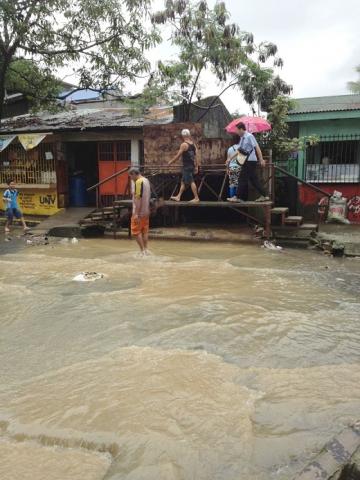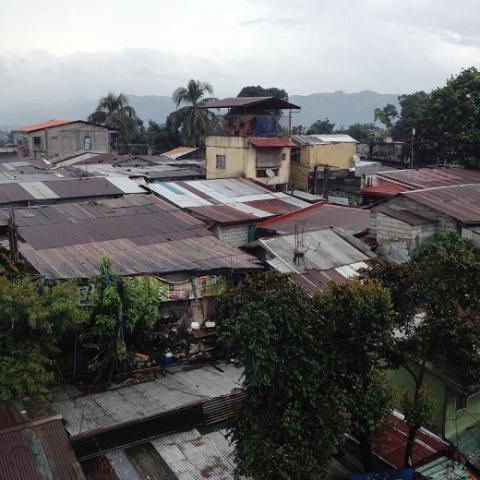There is an increasing focus on disaster preparedness in the Philippines, although this is happening at different levels. The general public is learning how to use the available technologies for monitoring hazards and to understand the language used. Many communities are also focused on evacuation strategies and on identifying safe centres that can be used in the event of a disaster.
On December 9, 2014, after Typhoon Hagupit (known as Ruby in the Philippines) passed through Metro Manila, representatives of Environmental Science for Social Change (ESSC), International Organization on Migration (IOM) and Simbahang Lingkod ng Bayan (SLB) visited some evacuation centres in Barangay Payatas in Quezon City to review disaster response and identify gaps and further needs. They found that a yearlong effort to build capacity for disaster management and planning in Payatas appears to have paid off. For example, some residents voluntarily evacuated from landslide-prone areas when warnings for Typhoon Hagupit were issued. The Quezon City Disaster Risk Reduction and Management Office also prompted the barangay to implement forced evacuation for households at-risk to flood. The Payatas Community Service Brigade was instrumental in this effort. SLB’s efforts were also critical to improving community disaster awareness and clarifying the roles and responsibilities of local stakeholders. Although Hagupit did not cause significant damage, the action of the community and local government indicates improved preparedness and response capacity.
 Over the past year, the Philippine Working Group on Disaster Risk Resilience (PWG) has focused on reviewing design and construction standards, particularly for affordable housing, but it also recognizes the need to include evacuation centre design and construction. The visit to Payatas was an opportunity to look at the possibilities of assessing the structural capacity and safety limits of some evacuation centres.
Over the past year, the Philippine Working Group on Disaster Risk Resilience (PWG) has focused on reviewing design and construction standards, particularly for affordable housing, but it also recognizes the need to include evacuation centre design and construction. The visit to Payatas was an opportunity to look at the possibilities of assessing the structural capacity and safety limits of some evacuation centres.
Communities, local governments, and building owners or managers (such as school principals and parish priests) need guidance in assessing the safety of their buildings. Engineering expertise is needed to make a comprehensive structural assessment, but PWG is also exploring the development of a simpler tool that can be used as an initial guide in deciding on the suitability of structures for use in evacuation, depending on the hazard.
The visit to Payatas revealed other aspects of infrastructure that need review. Drainage is critical, especially during periods of heavy rainfall when water is rapidly funnelled from roofs and streets into small, if not non-existent, channels. Creeks and waterways need maintenance, and in the case of Payatas, must be cleared of solid waste that can clog already narrow channels, resulting in backflow during heavy rains. Roads and bridges also need upkeep to ensure they are safe for use during a disaster.
In Payatas, particularly in the subdivision of Lupang Pangako, there are areas with unstable slopes that are prone to rain-induced landslides when saturated by rain. The local government constructed a retaining wall, but this seems insufficient to provide adequate protection from landslides and attention must be given to the safety and stability of local infrastructure.
IOM is exploring designs for “built-for-purpose” evacuation centres. Given the common practice of using schools as evacuation centres, it is also looking at building multipurpose structures, such as covered courts, to serve as evacuation areas and add to school facilities.
In the meantime, many communities will have to make do with existing structures that have limited capacity to withstand hazards. Therefore, local stakeholders will need guidance in making decisions about their safety and disaster risk reduction strategies and plans.
When the warnings were issued about Hagupit, comparisons were made to Haiyan, which struck in November 2013, in terms of the expected intensity and impact. Perhaps because of the devastation wrought by Haiyan and because the experience is still fresh in people’s minds, the warnings were effective in encouraging early evacuation.
 However communities must learn to prepare for all types and combinations of events, regardless of their previous experiences. When Typhoon Jangmi (known as Seniang in the Philippines) swept through on December 28, 2014, it was characterized by heavy rainfall, which resulted in flooding and landslides. Some communities fixated on wind warnings and were therefore unprepared for the impacts of heavy rainfall.
However communities must learn to prepare for all types and combinations of events, regardless of their previous experiences. When Typhoon Jangmi (known as Seniang in the Philippines) swept through on December 28, 2014, it was characterized by heavy rainfall, which resulted in flooding and landslides. Some communities fixated on wind warnings and were therefore unprepared for the impacts of heavy rainfall.
The visit to Payatas revealed improvements in the level of disaster preparedness, but also significant gaps. While communities are better able to respond to hazard warnings, it is important to focus on the time when there is no impending threat of hazard. It is precisely during this time that local governments and communities should focus on readying their infrastructure and planning their evacuation strategies. Focusing on disaster preparedness is critical to reducing people’s risk and strengthening resilience for the future. [ESSC]


